COMPARING FACES IN PHOTOGRAPHS
The First & Most Important Step
by Joelle Steele
 Comparing two faces in photographs to see if they are the same person is a lot more complicated than it seems. People can look deceptively similar, regardless of whether or not they are related. Even identical twins are not truly identical. That's probably why there are so many people trying to pass off their flea market photos as famous people, when the face in the photo is not who they think it is.
Comparing two faces in photographs to see if they are the same person is a lot more complicated than it seems. People can look deceptively similar, regardless of whether or not they are related. Even identical twins are not truly identical. That's probably why there are so many people trying to pass off their flea market photos as famous people, when the face in the photo is not who they think it is.
Part of the reason for so many mistaken identities in photo comparisons is just the fact that most people are not very good observers of faces. They often fixate on the similarities between two faces and ignore some pretty blatant differences. And even some experts – who should know better – rely on inaccurate measurement techniques, facial recognition programs, or overlaying one face on top of another. Those methods are highly unreliable when comparing two faces in photographs. More often than not, they result in matches that are not matches or non-matches that are matches.
To give you an idea of how inaccurate some experts are when comparing faces, here is how a plastic and reconstructive surgeon, Claude N. Frechette, MD, analyzed and compared an unidentified man in a Daguerreotype with two known photographs of Abraham Lincoln.

Frechette placed the photos side by side in order of their age, assuming the unidentified man on the left was the youngest. Then he drew lines to indicate where the eyes, nose, and mouth lined up, and then he measured them and compared the measurements. This is 100% inaccurate. And yet another expert, a facial recognition expert, Robert Schmitt, used biometrics to compare the same unidentified man to Abraham Lincoln and believed there was a probability that the unidentified man was Lincoln.
What do I think? Not a match. The first thing I look at in a photo comparison, when they are visible, are the ears. Ears are as unique as fingerprints. The unidentified man's ear is not anything like Lincoln's. There were several other things that didn't match either, such as the shape of the eyes, lips, chin, and ramus (the part of the jaw bone that starts underneath the ear and then curves out towards the chin).
I've examined all known photographs of Lincoln, so there is not a single thing I don't know about his face. I've also examined tens of thousands of faces and compared them to other faces, so I see the similarities and differences in faces long before I ever get around to measuring them. But, when it comes to authenticating an identity, there is only one way to correctly compare any two faces in photographs to see if they are the same person, and that is by measuring the face, converting the measurements to proportions, and comparing the proportions.
THE FIRST STEP
But before any measuring of the face can be done accurately, there is a very important First Step that absolutely must be taken: The alignment of the eyes and the sizing of the irises. I first learned this technique in 1976 from ear expert and author of "Ear Identification," Alfred Iannarelli. He had learned it but in his initial work with ear identification, he had not use for it. But, he referred me to forensic anthropologist Clyde C. Snow, PhD, who I met with in 1978, who also knew of this technique and recommended it. The same technique was also recommended to me by expert and author of "Anthropometry of the Head and Face in Medicine," Leslie G. Farkaš, MD, who I visited in 1981. I traveled extensively back in those days, and I learned that it pays to listen to the experts!
So why align and size the eyes? Because the only reliable features that can be used to begin even the most cursory examination of two faces are the eyes. They do not change in size or position on the head over time. A person can gain weight, lose weight, get wrinkles, develop ptosis (drooping eyelid), etc., but the eyeballs themselves will remain fixed in their sockets in the same position. Even if one iris is smaller than the other on the same face, that difference will remain consistent throughout a person's life. In addition, the irises are almost always evenly round or very close to it, so that if only a portion of the iris is visible beneath the eyelid, you can still measure its diameter from side to side.
And why should this First Step always be taken? It's actually very simple. Most faces are not perfectly straight or symmetric. This is because the underlying bony eye orbits are rarely evenly positioned in the skull. So, if two faces in photos are facing the same direction, and if they are definitely the same person, then aligning the pupils and sizing the irises will result in images in which the faces/heads are the exact same size and are 100% aligned or straight. However, if the two faces are not the same person, then aligning the pupils and sizing the irises will usually make it obvious that the faces are not of the same person. For example, if one person's eyes are larger in proportion to their head, you will see that the head of that person is much smaller than that of the person to whom they are being compared. In this way, the First Step allows you to immediately discover if you have a non-match so that you don't waste time measuring.
ALIGNING THE PUPILS
If you use a photo editing program such as Photoshop, you can easily align the pupils of the eyes by running a horizontal guideline through the center of the pupils of each face. You will almost always have to rotate both images to do this, and it ensures that the faces are straight.
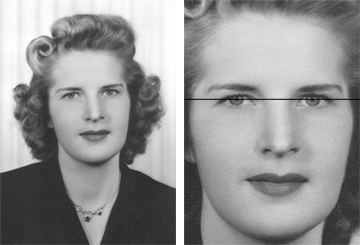
SIZING THE IRISES
Next, you must make the irises the same size. Again, use the horizontal guidelines at the top and bottom of the edge of the iris, or as in the photo below, use the vertical guidelines to get the diameter from side to side if you can't see enough of the iris from top to bottom. You will have to reduce or enlarge one of the faces until the irises are the same size on both faces. If one face has irises that are different in size (as in the photo below), then the other face should also have irises that are different in size in the same way. In that case, you can either work only with the larger iris in both images, or you can measure both of the mismatched eyes and compare them separately.

Above: sizing the irises using both vertical and horizontal guidelines. The right eye (on the left) is slightly smaller.
Remember that Lincoln comparison a few paragraphs back? Well, here's how it should have been done:
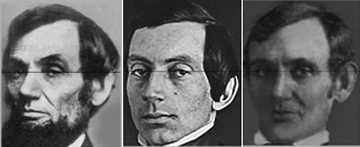
Above: Pupil alignment.
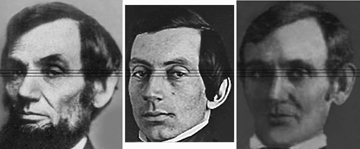
Above: Iris sizing.
As you can see, the pupil alignment and iris sizing reveal a significant difference between the unidentified man and the known photos of Lincoln. Because the unidentified man has eyes that are 1.45 percent larger than Lincoln's, his head is obviously smaller than Lincoln's. This is a very common difference that can really only be seen once the First Step is taken.
The following are a few examples of how resemblances between two faces can be deceptive at first glance, but then fall apart and reveal the differences once the First Step of adjusting the eyes has been done.
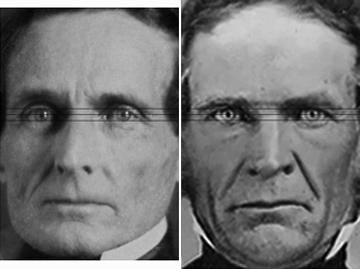
Above: Jefferson Davis (left) and unidentified man. Davis' face is shorter in height, along with other differences in the nose, mouth, chin, and probably eye color.
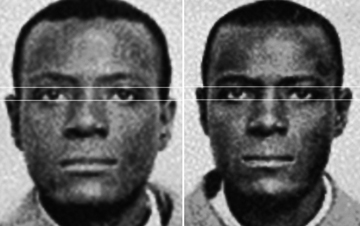
Above: Will West (left) and William West, ca. 1903. Met in prison, were probably twins separated at birth. The ears don't match, and when the eyes are adjusted, you can see the differences between the sizes of the heads.
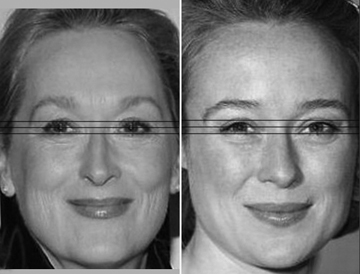
Above: Actresses Meryl Streep (left) and Jennifer Ehle. One of the closest non-matches I've ever seen. Streep's eyes are just slightly larger in proportion to her face, so her head is smaller than Ehle's, and the other differences (aside from the ears which are very different) are fairly minor.

